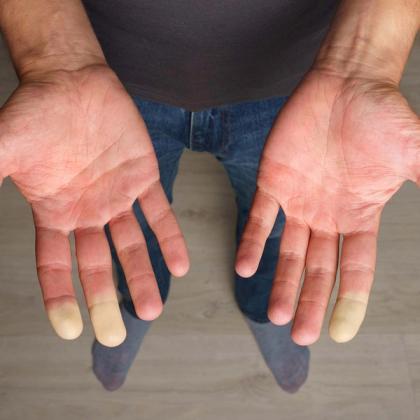Raynaud's phenomenon is a relatively common condition seen in primary care (especially during the autumn and winter months) that is characterised by vasospasm. This causes digits to change colour to white due to a lack of blood flow, usually brought on by cold temperatures. Affected areas subsequently turn blue due to deoxygenation and red due to reperfusion. The most common type is primary (idiopathic) Raynaud’s, affecting around 90% of people with the condition. Secondary Raynaud’s is often the initial manifestation of an associated underlying connective tissue disease. Both primary and secondary Raynaud’s can be painful, but secondary Raynaud’s can lead to complications from prolonged periods of ischaemia. In this episode, Dr Roger Henderson looks at the typical triggers for and presentation of Raynaud’s, along with lifestyle and treatment options including referral criteria.
Key take-home points
- Raynaud's phenomenon – often simply referred to as "Raynaud’s" – is a condition that affects the circulation of blood in certain areas of the body, most often the fingers and toes.
- It is characterised by episodic attacks of digital vasospasm and ischaemia on exposure to cold or, less commonly, emotional stress.
- This results in a characteristic triphasic colour change in the extremities (usually the fingers or toes): white (ischaemia), then blue (deoxygenation) rewarming with a slow blood flow and then red (reperfusion) where normal colour returns.
- Not all three phases are needed to make a diagnosis.
- The disease may occur as primary (idiopathic) Raynaud's phenomenon, which comprises the majority of cases (around 90%), or secondary Raynaud's phenomenon due to an underlying condition such as systemic sclerosis, systemic lupus erythematosus, vasculitis, atherosclerosis and hypothyroidism.
- Primary Raynaud's is more common in women and typically develops in the second or third decade. It is not associated with any other disease.
- The main risk factors identified for primary Raynaud's phenomenon are being female, having a family history of the condition, smoking and a history of migraine. In men, smoking and hand–arm vibration syndrome appear to be significant triggers.
- Secondary Raynaud’s often develops at an older age and particularly in males. It is often the initial manifestation of an associated underlying connective tissue disease and occurs in over 90% of patients with systemic sclerosis and in up to 40% of patients with systemic lupus erythematosus and idiopathic inflammatory myositis.
- Raynaud's phenomenon is diagnosed clinically, but in primary Raynaud's disease there is usually nothing to find on examination, as patients rarely present during the event.
- The treatment for primary or very mild secondary Raynaud’s usually consists of lifestyle changes and pharmacological therapies, whereas treatment for moderate-to-severe secondary Raynaud’s may warrant additional pharmacological therapies or even surgery if patients have progressed to digital ulceration or gangrene.
- Lifestyle measures include keeping warm and avoiding damp or cold (such as by wearing gloves, including when taking anything out of a freezer, and using hand warmers), moisturising dry skin, not smoking, avoiding injury to digits and vibration exposure and avoiding stress.
- Vasoconstrictor drugs and drugs known to exacerbate Raynaud’s, such as beta-blockers, ergotamine, clonidine, ciclosporin, caffeine, cocaine and amphetamines, should be avoided.
- Non-cardioselective calcium-channel blockers are the most widely used oral treatment for Raynaud's phenomenon as these promote relaxation of vascular smooth muscle cells and lead to vasodilatation.
- Nifedipine is the most commonly used, typically at an initial dosage of 10 mg once daily. This dose is increased to 10 mg twice daily after a week and thereafter increased gradually to 20 mg twice daily. The maximum dosage (if tolerated) is 20 mg three times daily.
- There is a lack of evidence for the use of vasodilators other than calcium-channel blockers in Raynaud’s.
- Surgical intervention may be considered for severe and disabling symptoms, but there is limited evidence in support of this; although, for patients with secondary Raynaud’s who have progressed to digital ulceration or gangrene, surgery may be required.
- Approximately 13% of patients later develop an underlying disorder such as scleroderma.
Key references
- Curtiss P, et al. J Am Acad Dermatol. 2024;90(2):223-234. doi: 10.1016/j.jaad.2022.06.1199.
- Garner R, et al. BMJ Open. 2015;5(3):e006389. doi: 10.1136/bmjopen-2014-006389.
- Rirash F, et al. Cochrane Database Syst Rev. 2017;12(12):CD000467. doi: 10.1002/14651858.CD000467.pub2.
- Belch J, et al. Vasa. 2017;46(6):413-423. doi: 10.1024/0301-1526/a000661.
- Su KY, et al. Cochrane Database Syst Rev. 2021 May;5(5):CD006687. doi: 10.1002/14651858.CD006687.pub4.
- Roustit M, et al. Ann Rheum Dis. 2013;72(10):1696-9. doi: 10.1136/annrheumdis-2012-202836.
- Herrick AL. Ther Adv Musculoskelet Dis. 2017;9(12):317-329. doi: 10.1177/1759720X17740074.
- NICE. 2015. https://www.nice.org.uk/advice/esuom42/chapter/full-evidence-summary.
Create an account to add page annotations
Add information to this page that would be handy to have on hand during a consultation, such as a web address or phone number. This information will always be displayed when you visit this page
